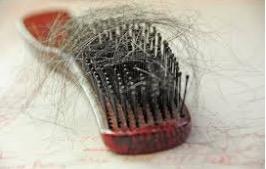
This story has it all. Donald Trump's hair, drug prices, enlarged prostates, and a way for you follically-challenged guys to save a ton of money by sticking it to Merck.
Last week, there were a number of stories about some of President Trump's medications. Nothing all that captivating. But, if you scratch the surface, there's some interesting biochemistry going on with one of them—Propecia, the drug that keeps men from losing their hair.
There are a total of two approved hair loss drugs available for men (1). One of them doesn't suck. Let's look:

The generic name for Propecia is finasteride. It works rather well. Not only does it stop hair loss in men, but it can also cause hair to grow back. And don't think that this doesn't have an effect on one's social life:

Let's take a look at the science of what is going on. It will answer a couple of questions:
- How the exact same drug (finesteride), which was approved for benign prostatic hyperplasia (BPH) in 1992, became a drug for hair loss in 1997, and at a much lower dose.
- The right and wrong way to talk to your doctor, if you want the meds, and you want 'em cheap.
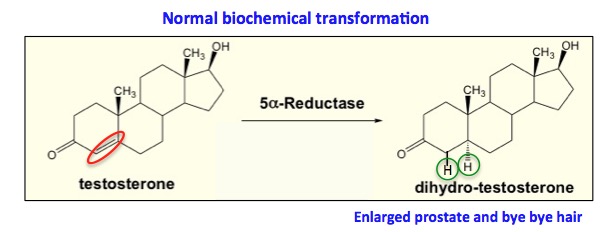
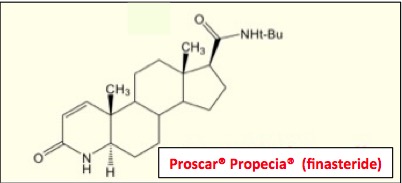
Finasteride blocks the action of dihydrotestosterone reductase:

Inhibition of dihydrotestosterone reductase shrinks enlarged prostate glands and reverses hair loss
Dihydrotestosterone reductase, also called 5α-reductase is an ubiquitous mammalian enzyme that plays multiple roles in sexual development in both males and females. It carries out one very simple reaction—the conversion of testosterone to dihydrotestosterone (DHT) by simply saturating (2) a carbon-carbon double bond (red oval) with two hydrogen atoms (green circles).
Although the transformation of testosterone to DHT is about as simple as biochemical reactions get, and the two chemical structures are almost identical, try telling that to your body. The difference between the two sex hormones is profound.
This is because there are two similar, but functionally different types of 5α-reductase (called isoforms). One is called type 1 5α-reductase and the other type 2 5α-reductase (Creative, no?). The type 1 enzyme is found throughout the body, but the type 2 isoform is concentrated in the genitals and prostate. The isoforms also react differently to medication. Finasteride binds 100-times more tightly to the type 2 isoform, so it will be concentrated in your genital area. This will substantially decrease your time at the urinal.
(For a complex analysis of how men select which urinal to use, you can read this piece of idiocy: "Good Minds Go To Waste- The Math Of Urinal Selection."
The function of the type 2 reductase enzyme is also responsible for enlarged prostate glands, once it outlives its usefulness. DHT is involved with development of the testes, penis, and scrotum as well as promotion of the growth of the prostate. Despite the fact that 60-year old men rarely have the need to go through puberty, DHT nonetheless continues to be made in the body, causing enlarged prostate glands—the reason why older men often have difficulty in urinating. By blocking the conversion of testosterone to DHT, finasteride not only stops prostate growth, but actually causes it to shrink.
The reversal of hair loss is a result of inhibition of the type 1 enzyme. Male pattern baldness, the most common form in men, is caused by the conversion of testosterone to DHT in the hair follicles of the scalp, which causes the follicles to shrink. And when they shrink, they become even more sensitive to DHT. By lowering the amount of DHT in the scalp, finasteride has a direct, beneficial effect on the heath of follicles, which is why it can promote hair regrowth.
So, how can you use this information to your advantage? Following are two techniques you could use to get finasteride from your physician:
Strategy #1. "Doc, I'm no great beauty even with hair, but it's falling out. Women find me even more repulsive than usual! Can you help?"
Result:
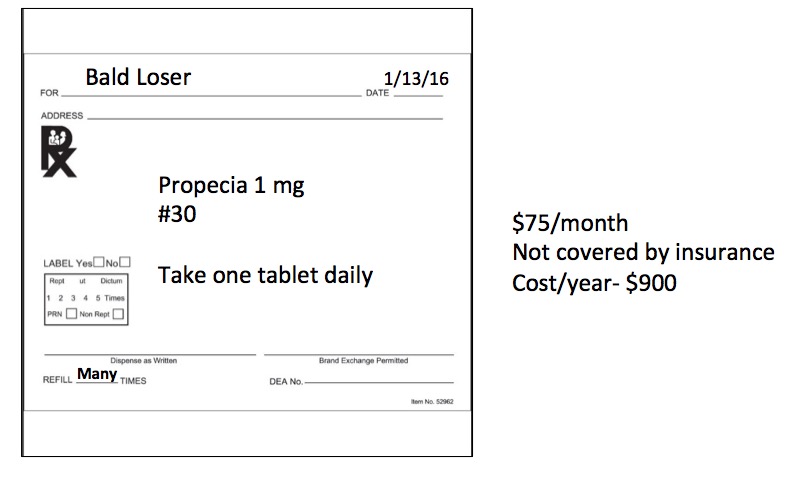
Or, you could choose...
Strategy #2: "Doc, I got a prostate size of a deviled egg, and I'm dribbling like the Harlem Globetrotters."
Result:
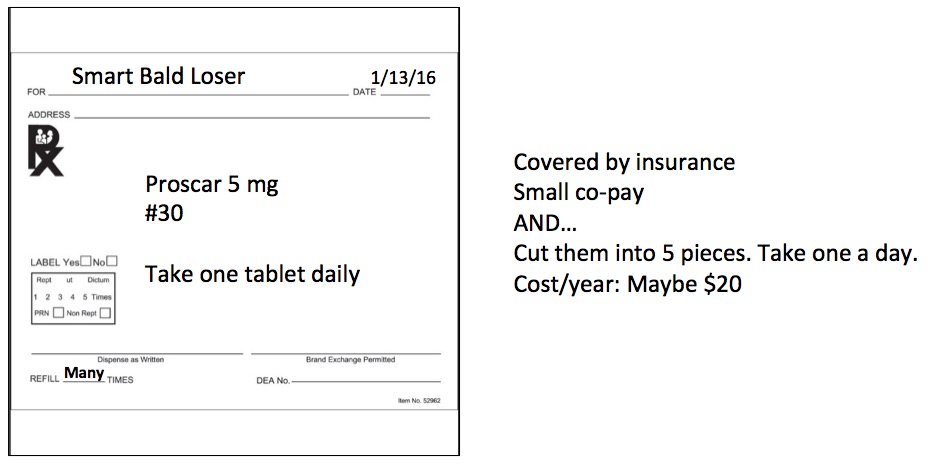
So, there ya go. We middle-aged guys need all the help we can get. Growing back your hair won't work as well with the ladies as a private jet, but at least you'll get to save a few bucks, and screw Merck at the same time. At least you'll be screwing someone.
Whether President Trump actually wants to keep his hair and, if so, how to wear it, is a matter for arbiters of style. Likewise, I shall pass on the opportunity to dwell on his urinary habits, although please feel free to do so on your own. Comments welcome. Sort of.
Note:
(1) Propecia is for men only. It does not work for women at all. Rogaine sucks for both genders.
(2) In organic chemistry, the term means adding hydrogen to the molecule. When polyunsaturated fats are reacted with hydrogen, they become either partially hydrogenated fats or saturated fats, depending on the amount of hydrogen used.



